2. Mortality from diseases in 1936 to 2010
2.1 Mortality from tuberculosis, influenza and other infectious diseases in 1936 to 2010
In the 1930s and 1940s, infectious diseases were the most significant cause of death category: around one quarter of all deaths resulted from them in 1936. A considerable number of deaths from infectious diseases, around 60 to 70 per cent, was caused by tuberculosis (Figure 2). The most common type of tuberculosis was pulmonary tuberculosis or consumption. Other big infectious disease groups were whooping cough, diphtheria and influenza, which in 1936 was included in infectious diseases.
Figure 2. Tuberculosis mortality in 1936 to 2010 per 100,000 persons of the mean population
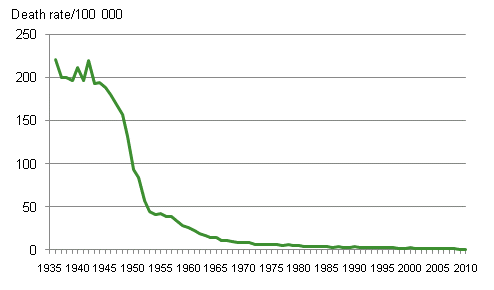
Tuberculosis mortality was high before the Second World War and during it. Even if the food and housing situation was poor in the 1940s during the war, the tuberculosis situation did not actually get worse. On the other hand, the situation deteriorated among young and middle-aged men. This was evidently connected to the difficult conditions on the war front, such as overcrowded housing. Tuberculosis caused exceptionally many deaths in 1942, when the war was still ongoing. The high number was possibly also a result of the difficult food situation and partial interruption of sanatorium care when the Continuation War broke out in 1941.
After the war, tuberculosis mortality started to abate from 1945 onwards. This was an outcome of protective vaccination and the antibiotics introduced to treat the disease. Difficulties in the war and depression time eased off, and tuberculosis mortality diminished considerably. The standard of living also rose rapidly after the war, and the quality of food and housing improved and new more hygienic ways of life were adopted. After 1967 tuberculosis mortality has been under ten deaths per 100,000 population per year. In 2010, 48 persons died from tuberculosis.
Influenza was also a significant cause of death in past years (Figure 3). A wave of influenza was experienced in 1936, when 1,725 persons died from influenza.
Figure 3. Influenza mortality in 1936 to 2010 per 100,000 persons of the mean population
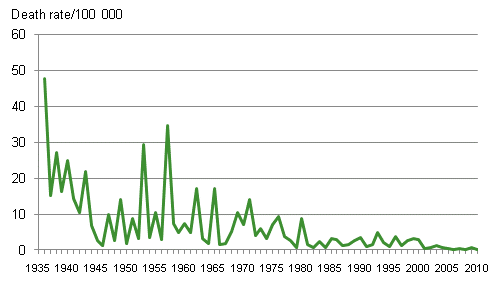
Between 1956 and 1958 the "Asian" influenza raged in Finland, resulting in 1,800 deaths. From 1968 to 1971 the influenza came from Hong Kong, causing the death of 1,000 persons in those years. Between 1975 and 1976 the "Muscovite" claimed the life of nearly 800 persons. After that, influenza has caused at its highest 250 deaths per year. In 2010, nine persons died from influenza.
2.2 Mortality from lung cancer in 1969 to 2010 1)
Mortality from lung cancer among women has increased during the last four decades, but among men it started to decline already in the 1980s.
Most European countries have developed in the same way as Finland; male mortality from lung cancer is falling and the female one is increasing. Smoking is the most significant risk factor related to lung cancer. As smoking by women has grown, female lung cancer mortality has also started to rise.
Figure 4. Lung cancer mortality in 1969 to 2010 per 100,000 persons of the mean population
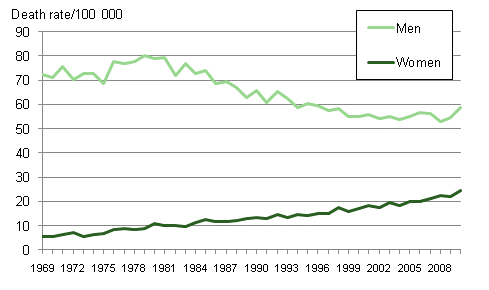
2.3 Mortality from breast cancer in 1936 to 2010
Mortality from breast cancer has been growing steadily from the 1930s to 1990s, but the growth seems to be slowing down slightly during the 2000s. Nevertheless, breast cancer is the most common type of cancer among women.
Mortality from breast cancer has started to decline in many European countries. In Finland, breast cancer mortality among working-age women has fallen during the last twenty years by around one fifth. The age-standardised figures also show that mortality from breast cancer is falling. It has been found that screening has diminished the mortality rate from breast cancer particularly among women aged 50 or over.
Figure 5. Breast cancer mortality in 1936 to 2010 per 100,000 women of the mean population
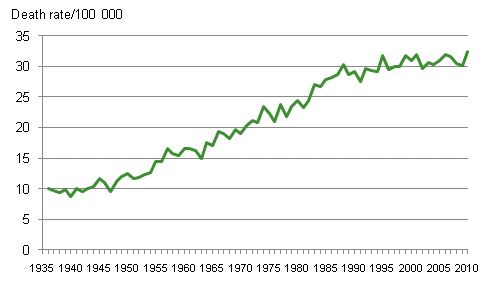
Alongside alcohol-related causes, breast cancer is the most common cause of death among women of working age. Breast cancer was a slightly more common cause of death among them in 2010 than alcohol-related causes, but the difference between these two has not been great in 2010 or in any previous year either. Breast cancer mortality among working-age women was in 2010 slightly higher than in 2009 and deaths from alcohol-related causes went down from the previous year. In 2010 the number of deaths from breast cancer was 886, that is, 32 deaths per 100,000 women.
2.4 Mortality from prostate cancer in 1936 to 2010
The graph for mortality from prostate cancer follows almost the same shape as that of breast cancer mortality. However, it has lagged somewhat behind the trend of breast cancer mortality. When all cancers are taken into consideration, the highest number of men get prostate cancer but most commonly men die from lung cancer. External factors, such as the environment and manner of living have the most effect on prostate cancer, similarly as on other cancers.
Figure 6. Prostate cancer mortality in 1936 to 2010 per 100,000 men of the mean population
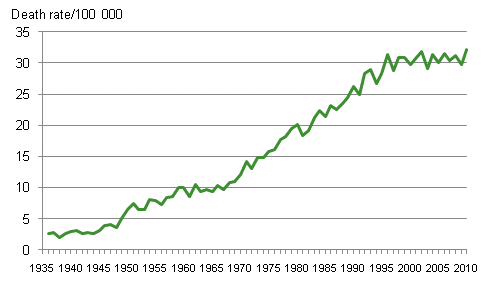
Prostate cancer mortality was in 2010 on level with women's breast cancer mortality, that is, 32 deaths per 100,000 men. In 2010 the number of deaths from prostate cancer was 845, while in 2009 it was 778.
2.5 Mortality from ischaemic heart disease in 1969 to 2010 2)
Diseases of the circulatory system, such as ischaemic heart disease, are nowadays the most common causes of death in Finland. Ischaemic heart disease causes the death of every fifth person.
Figure 7 shows ischaemic heart disease mortality age-standardised. In age standardisation the effect of the age structure of the population and its changes are eliminated. In this case it is seen at which level mortality from ischaemic heart disease would be if the age structure of the population remained unchanged during the whole reference period. When the ageing of the population is eliminated from the figures by age standardisation, it can be seen that ischaemic heart disease mortality has fallen evenly over the last 40 years.
Figure 7. Age-standardised ischaemic heart disease mortality in 1969 to 2010 per 100,000 persons of the mean population
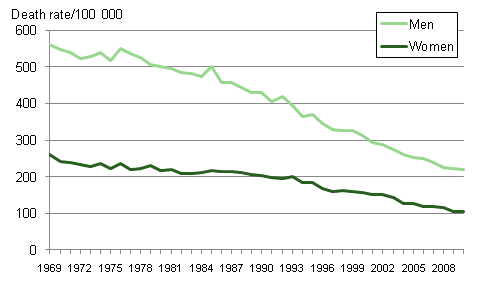
The decrease in ischaemic heart disease mortality has been significant particularly among middle-aged people during the last decades. In the 1960s, mortality among working-age men from this disease was still one of the highest in the world, but after that mortality has been going down noticeably. During the reference period, mortality among working-age men from ischaemic heart disease has fallen by as much as 81 per cent.
2.6 Deaths from dementia and Alzheimer's disease in 1969 to 2010
In 2010, nearly every fifth death at the age of 80 or over was caused by dementia or Alzheimer's disease. The number has more than doubled over the past 20 years. The growth is partly caused by improved diagnostics, but also clearly by the ageing of the population.
Figure 8. Age-standardised dementia mortality (incl. Alzheimer's disease) in 1969 to 2010 per 100,000 persons of the mean population
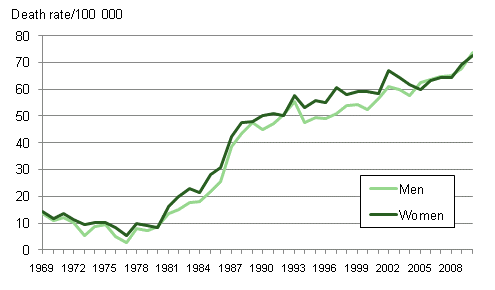
Because dementia becomes more common steeply with age, along with the lengthening of life expectancy, more people get dementia and die as a result of it. This concerns particularly women, because women live longer than men do, on average. The number of deaths from dementia and Alzheimer's disease was 6,057 in 2010. Sixty-nine per cent of them were women. Around two-thirds of deaths were caused by Alzheimer's disease.
1) Comparable data on mortality from lung cancer are available only starting from 1969.
2) Comparable data on mortality from ischaemic heart disease are available only starting from 1969.
Source: Causes of death, Statistics Finland
Inquiries: Marja-Liisa Helminen (09) 1734 3273, Helena Korpi (09) 1734 3605, Irmeli Penttil� (09) 1734 3253, kuolemansyyt@stat.fi
Director in charge: Jari Tarkoma
Updated 16.12.2011
Official Statistics of Finland (OSF):
Causes of death [e-publication].
ISSN=1799-5078. 2010,
2. Mortality from diseases in 1936 to 2010
. Helsinki: Statistics Finland [referred: 19.4.2025].
Access method: http://stat.fi/til/ksyyt/2010/ksyyt_2010_2011-12-16_kat_003_en.html

